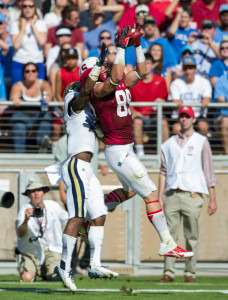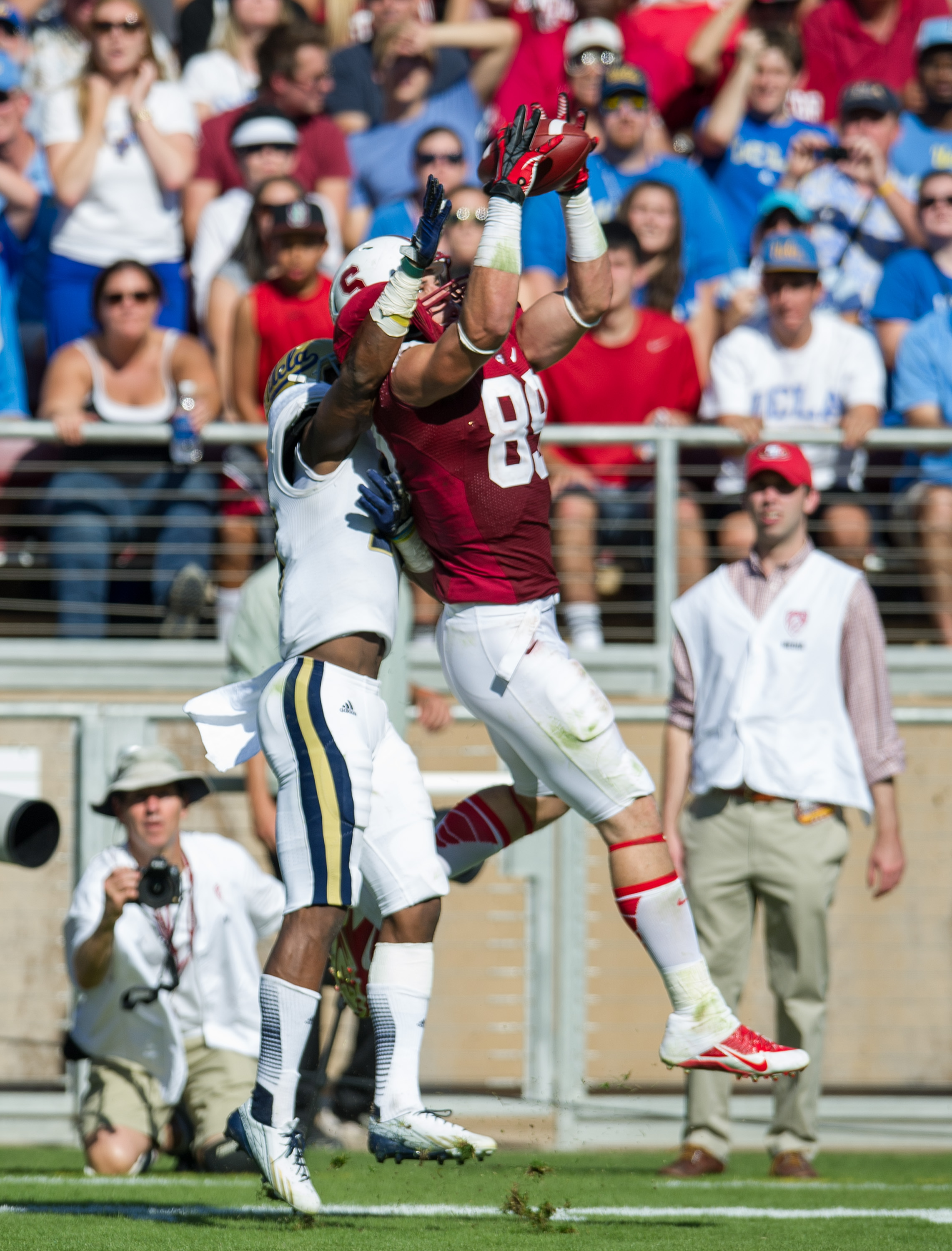Though it didn’t come to the forefront in the Cardinal’s blowout win against Cal, head coach David Shaw’s play calling has been one of the most controversial aspects of the 2013 Stanford football season. Stanford’s performance in pressure situations hasn’t been all bad, however. Despite the team’s well-documented red zone struggles, it still leads the Pac-12 in third down efficiency (51.6 percent). We asked football writers Winston Shi, Do-Hyoung Park and David Cohn: What is Stanford doing wrong in the red zone, but right on third down?
Winston: The red zone and your typical third down are not the same. Put simply, it’s not easy to score in the red zone, and history has made it pretty clear that otherworldly red zone touchdown percentages require an equally otherworldly quarterback. Stanford shouldn’t expect the ratios of the Luck era, but as we’ve all explained to death, Stanford’s red zone TD percentage is still by no means satisfactory. (Note that TD percentages are far more important than scoring percentages; as Oregon’s near-comeback against Stanford illustrated, you can win games by forcing field goals in the red zone.)

The key difference between the red zone and the rest of the field (where the majority of third downs will occur) is the lack of space. Offenses can’t stretch the field vertically with deep routes, which allows the defensive secondary to blitz the pass and crash down on the run. This mitigates the Stanford offense’s greatest strength: its offensive line. The Tunnel Workers Union may be excellent, but if the defense is dialing up the blitz inside its own 20, it’s not easy to block the extra player(s) no matter how good Stanford’s guys are.
At midfield, the Cardinal can run a couple times to set up third-and-short. In the red zone, that’s a considerably more dicey proposition. Why do offenses (not just Stanford’s) throw fades to the corner so often in the red zone? Because the fade is the one play in football where the offense is almost assured of single coverage. In the red zone that quality becomes all the more important. At some point you will have to throw the ball in the red zone. There are good plays to call, but at the end of the day it’s all about execution — there is no “magic bullet.”
Do: I honestly don’t really think that you can compare the so-called “pressure situations” that are third down opportunities and red zone opportunities with numbers like that. As a matter of fact, if you’re going to cite the numbers like the prompt did above, you’ll find that the Cardinal has scored touchdowns on 23 out of its 40 red zone trips this season — good for a 57.5 percent conversion rate, higher than its third down conversion rate of 51.6 percent. So right off the bat, we can see that this way of thinking is flawed, to say the least.
Like Winston said, the touchdown-to-trip ratio could obviously use some work, especially given Stanford’s style of game management. As Winston said above, the main difference is that it’s not possible to stretch the field in the red zone, especially since Ty Montgomery and Michael Rector are most effective in space where they can use their speed to create separation.
The main issue has been that the Cardinal has been unable to develop a consistent intermediate passing game this season, particularly after Devon Cajuste got injured after some promising contributions in that area during the UCLA game. Without much of an intermediate passing game to speak of, the Cardinal is really limited in what it can do and it’s much easier on defenses to load the box and limit the Cardinal to three.
And that’s not necessarily something that Stanford is doing right on third down either, making it one of the notable flaws of this offense. We consistently see the Cardinal not being able to convert as effectively on third-and-long as it can on third-and-short because of its inability to consistently pick up 10-20 yards through the air. Until that can happen, Stanford won’t be able to improve noticeably in either of these situations.
David: I agree with Winston that third down and red zone situations are distinct entities. However, in commenting on Stanford’s performance in the red zone, the numbers say that the Cardinal has not been as bad in the red zone as it may seem. The percentage that Do cites for Stanford’s red-zone touchdown conversion rate (57.5 percent), may be in the lower half of FBS programs, but the Card’s conversion of red zone opportunities into points is nearly 88 percent, good for 30th among the 123 FBS schools.
At the same time, I certainly cannot fault Stanford fans who are concerned with the Cardinal’s ability to punch it into the end zone. My first explanation for this phenomenon would be the loss of tight ends Zach Ertz and Levine Toilolo. Ertz and Toilolo were nightmares for opposing defenses to cover, as their size and sheer athletic ability posed immense challenges for most opposing secondaries with smaller defensive backs. However, the graduation of Ertz and Toilolo, coupled with the lack of a consistent receiving threat at the tight end position this season, has greatly reduced the Card’s available options inside the 20.
In addition, top wideouts Montgomery and Rector are most effective in space, which is inherently hard to come by as the offense approaches the end zone. Finally, the injury to Devon Cajuste has limited the slot receiver to one catch for 19 yards in the last four games. When he is completely healthy, Cajuste can be a playmaker in the red zone for the Cardinal. In short, a perfect storm of events has limited the Card’s effectiveness at putting seven points on the scoreboard inside the 20-yard line. However, I have confidence that Stanford will be able to remedy this problem in the Pac-12 Championship Game against Arizona State, a team that gave up 39 points to the Cardinal in the first three quarters of September’s matchup.
